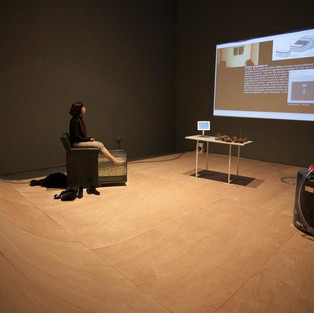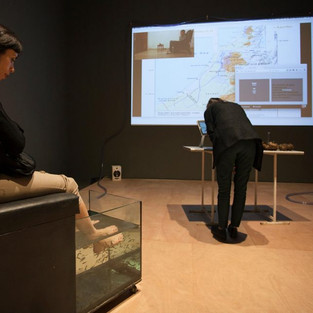Susanne M. Winterling: The Bladder of Gaia
- Majd Qumseya
- Jan 5, 2017
- 1 min read
Part of Conditions of Political Choreography
The Bladder of Gaia is a multi-species series of rituals. It consists of individual fish pedicures conducted while being immersed in sound and data visualization projected on the surrounding walls as well as a water ritual that revitalizes plants. The visualizations depict information associated with an aquifer referred to as “The Bladder of Gaia” and includes a live stream connection with the artist who is located in the desert. Via a technological substitute, the artist is both present and absent, paralleling the presence and absence of water, one of the main motifs in this work. Focusing on the instrumentalization and necessity of resources and living knowledge, the creepy but cathartic ritual offered to viewers in The Bladder of Gaia creates a space for the contemplation of climate science and landscape tropes. It reflects and critiques territorial behavior in the age of software, Big Data, and geo-biopower whose nexus is water and the commons.
Susanne M. Winterling (b.1970 in Rehau, Germany, lives in Berlin) studied at the Art Academies of Hamburg and Braunschweig. She is a founding member of the artist collective Akademie Isotrop. Winterling’s practice is influenced by philosophy, artificial intelligence, and ecofeminism. Her recent body of works centers on technology and biology and favors the haptic and poetic, especially against the nature/culture divide. Her recent works and projects exploring phenomena of bioluminescence have been shown in the Lulennial in Mexico City; nature after nature at the Fridericianum in Kassel; The Climatic Unconsciousness at Remai Modern in Saskatoon; Corruption: Everybody Knows… at e-flux in New York; and in the traveling project In Search of Radical Incomplete, A Perfect Animal Within.














Comments